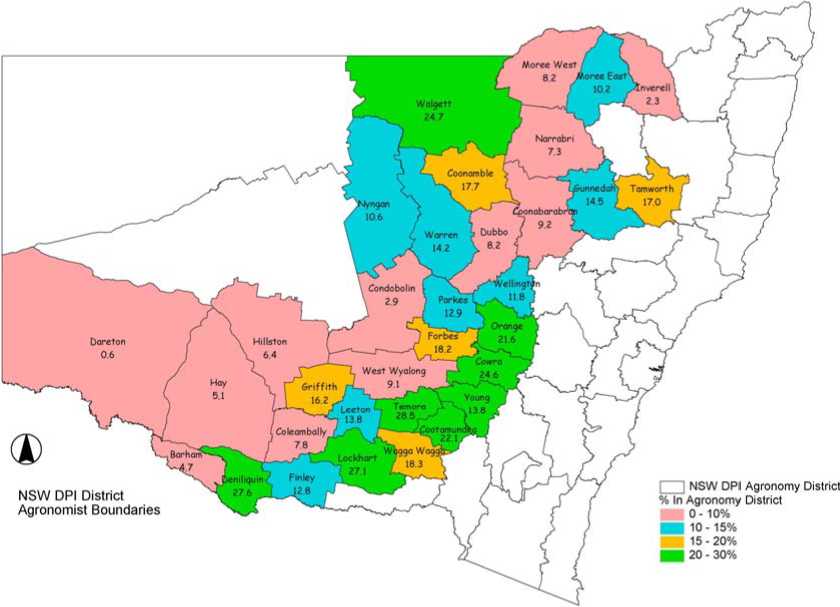The Agronomy Districts are illustrated in Figure 2, where the relative importance of broadleaf
crops as a percentage of total crop area in 2001 is shown. The wide regional differences in
levels of importance of broadleaf crops are evident. While broadleaf crops are more important
in the south-east in 2001, there are some parts of the north where broadleaf crops are also
important.
Figure 2: Broadleaf Crop Percentage, by NSW Department of Primary Industries
Agronomy Districts, 2001

Source: Map prepared by Peter Worsley, NSW Department of Primary Industries
At the regional level, there are also some wide differences in the direction of change in the
relative importance of pulse and oilseed crops. The changes in the area of winter crops are
shown in (Table 5) and are illustrated in Figures 3 and 4. More detailed figures on the area
sown to each crop in each region are shown in Appendix B.
Pulses are relatively more important in the northern areas, with rapid growth in recent years in
both the north-east and the north-west regions. This has been due to growth in chickpeas and
faba beans. Winter oilseeds (ie, canola) have become particularly important in the south-east
region, and have grown from very low levels in each of the other regions.
Thus, the percentage of the area sown to winter pulse and oilseed crops in the north-east
region has increased since 1993, although there was a relatively high proportion in the
drought of 1994 (Figure 3). Similarly, in the north-west region the percentage of winter crops
sown to pulses and oilseeds has increased steadily since 1993. For instance, the role of
chickpeas increased substantially in the drier Walgett area in 2001 and 2002, but production
will be variable depending on the availability of stored subsoil moisture.
More intriguing information
1. The name is absent2. Spectral density bandwith choice and prewightening in the estimation of heteroskadasticity and autocorrelation consistent covariance matrices in panel data models
3. Biologically inspired distributed machine cognition: a new formal approach to hyperparallel computation
4. The name is absent
5. ESTIMATION OF EFFICIENT REGRESSION MODELS FOR APPLIED AGRICULTURAL ECONOMICS RESEARCH
6. Literary criticism as such can perhaps be called the art of rereading.
7. Database Search Strategies for Proteomic Data Sets Generated by Electron Capture Dissociation Mass Spectrometry
8. The name is absent
9. The name is absent
10. Work Rich, Time Poor? Time-Use of Women and Men in Ireland